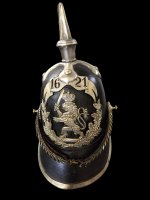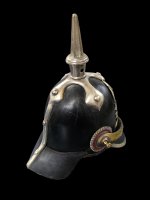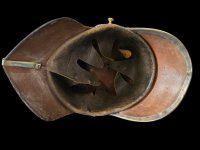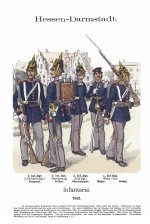You are using an out of date browser. It may not display this or other websites correctly.
You should upgrade or use an alternative browser.
You should upgrade or use an alternative browser.
M49 Hessian
- Thread starter Amybellars
- Start date
2nd.Leibhusar
Well-known member
Great find !
John Josef
Well-known member
Nice helmet seems you're really getting into the early Helmets lately. 

I seem to be heading in the opposite direction with being more interested in wartime produced pickelhaubes and the last models produced before being totally replaced with the Stahlhelme.
I seem to be heading in the opposite direction with being more interested in wartime produced pickelhaubes and the last models produced before being totally replaced with the Stahlhelme.
Kaiser Wilhelm II
Well-known member
A stunningly incredible piece.
Pontiac9999
Well-known member
Amazing find...!
KAGGR#1
Well-known member
Very niceI have yet to research on this but I guess it's a m49 model.
Very nice with no extra holes and in great condition.
Regards
Amy Bellars View attachment 53671View attachment 53672View attachment 53673
and I really like it
But I am not up on early helmets
I assume it is Hessian I R 115 ( not 115 at that early time ?)
Also someone fill me in
this is silver / nickel finish
I have seen the early I R 115 in gold trim
then the last pre war trim is is back to silver ??
Thanks
Steve
Nacuaa
Active member
This is the first time I have ever seen anything like this - a Hesse Darmstadt helmet with a bandeau date. I assume it is a IR 115 as well since that date is associated with the regiment's founding following what Tony has written. I think Amy has discovered something entirely unique - a new contribution to pickelhaube history. I will be curious to see what she comes up with in her research.
Nacuaa
Active member
Given the height and shape of the helmet and the white metal fittings I would guess that it predates the two appearing here.
If true, Amy's helmet would indicate that there is a cycle - switching from white metal first to yellow metal fittings and back again across the 19th century. Its the source of inspiration for the late white metal fittings we appreciate in the later helmets then.
Attachments
Amybellars
Well-known member
There is not much of info on the old helmets. I will continue my info finding
Sandmann
Well-known member
Amy, I have found the following information about early Hessian Pickelhauben:
From a book called “Hessisches Militär zur Zeit des Deutschen Bundes” which contains the following information about the helmet:
Kurhessian military (Hesse-Kassel):
By AKO of 18.6.1845, helmets based on the Prussian model M1842 (with squared front visor, yellow fittings and smooth spike) were introduced. The introduction took place step by step from 1845, but the helmets had the following differences:
Helmets with brass fittings were introduced by AKO of 11.3.1849. It was similar to the Prussian helmet, but with the following differences:
Hesse-Kassel (press link):
In the book “Geschichte des 1. grossherzoglich-hessischen Infanterie-(Leibgarde-)Regiments Nr 115: 1621-1899” the following information can be found:
From a book called “Hessisches Militär zur Zeit des Deutschen Bundes” which contains the following information about the helmet:
Kurhessian military (Hesse-Kassel):
By AKO of 18.6.1845, helmets based on the Prussian model M1842 (with squared front visor, yellow fittings and smooth spike) were introduced. The introduction took place step by step from 1845, but the helmets had the following differences:
- The 3 infantry regiments wore as an emblem a Hessian lion striding to the left in the heraldic sense in an upright position with a simple tail. He has a crowned head and holds a sword in his right hand, which points diagonally over his head and crown. There was no foliage under the lion.
- The chinscales were convex, under the right chinscale was a cockade (red with a white (silver for officer‘s) ring).
- Officers wore gilded fittings and, as in Prussia, small stars to fasten the fittings.
- The Life Guards Regiment wore nickel-silver fittings with a fluted spike and nickel-silver emblem. The chinscales, however, were gold-plated. The emblem was not the lion, but the star of the Order of the Lion. For officers, the central field of the star was enameled.
The artillery wore helmets like those of the infantry, only with balls instead of spikes. The helmets of the pioneers were also similar to those of the infantry, only with nickel-silver fittings.
Helmets with brass fittings were introduced by AKO of 11.3.1849. It was similar to the Prussian helmet, but with the following differences:
- The front visor was round and the spike was fluted.
The chinscales were convex and the Hessian cockade was worn under the right-hand chinscale (white with 2 red rings).
A lion similar to that of Hesse-Kassel was worn as an emblem. The only difference was that it had 2 tails and a semicircular wreath of laurel and oak leaves (50/50) was attached below it.
- The uniforms of the 4 Inf. regiments of the Electoral Hessian army divisions (Hesse-Kassel) were confusingly similar to the Prussian regiments.
- The helmet of the Leibgarde Regiment was similar to that of the Prussian 1st GRzF, except that the nickel-silver Kurhessian Star of the Order of the Lion was worn as an ornament. The Life Guards Regiment then formed the core of the Fusilier Regiment No. 80.
- The 3 line infantry regiments wore yellow brass fittings.
Hesse-Kassel (press link):
- Helmet similar to Prussia.
- An infantry helmet M1845/46 from the museum in Rastatt weighed 620 g and was 322 mm high.
- An infantry helmet M1849 from the museum in Ingolstadt weighed 730 g and was 303 mm high.
- Only artillery officer‘s wore a pearl ring and stars to attach the fittings.
In the book “Geschichte des 1. grossherzoglich-hessischen Infanterie-(Leibgarde-)Regiments Nr 115: 1621-1899” the following information can be found:
- The award ribbon with the year “1621” was introduced by AKO on December 5, 1871 (retrospectively for the 250th anniversary).
Last edited:
Nacuaa
Active member
It seems from the early Hesse Darmstadt helmet on the left presented recently by J.LeBrasseur that the 1621 bandeau preceded 1871.
Nacuaa
Active member
I tried to read up on Hesse Darmstadt and Hesse Cassel between 1815 and 1866 on line and I'm entirely confused. Did Prussia force a reorganization of the Hesse estates after the Austro-Prussian War?
If this is the first model Hesse Darmstadt IR 115 Leibgarde Regiment then it may have been worn by the 2nd Battalion of the Hesse Leibgarde Regiment of the 2nd combined brigade under Major General von Spangenberg as part of the German Federation Army during the 1st Schleswig Holstein War.
If this is the first model Hesse Darmstadt IR 115 Leibgarde Regiment then it may have been worn by the 2nd Battalion of the Hesse Leibgarde Regiment of the 2nd combined brigade under Major General von Spangenberg as part of the German Federation Army during the 1st Schleswig Holstein War.
Last edited:





